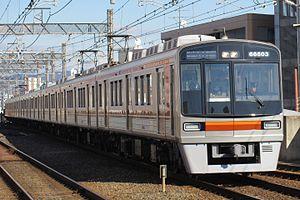| Osaka Metro Sakaisuji Line | |||
|---|---|---|---|
 A refurbished Sakaisuji Line 66 series EMU in January 2016 | |||
| Overview | |||
| Native name | 堺筋線 | ||
| Owner | Osaka Metro (2018–present) Osaka Municipal Transportation Bureau (1969–2018) | ||
| Line number | 6 | ||
| Locale | Osaka | ||
| Termini | Tenjimbashisuji Rokuchōme Tengachaya | ||
| Stations | 10 | ||
| Service | |||
| Type | Rapid transit | ||
| System | Osaka Metro | ||
| Depot(s) | Higashi-Suita (located on Hankyu Senri Line) | ||
| Rolling stock | 66 series EMUs, etc. | ||
| History | |||
| Opened | December 6, 1969 | ||
| Technical | |||
| Line length | 8.1 km (5.0 mi) | ||
| Track gauge | 1,435 mm (4 ft 8 1&fras1;2 in) | ||
| Electrification | 1,500 V DC, overhead line | ||
| Operating speed | 70 km/h (45 mph) | ||
| |||
| Route map | ||||||||||||||||||||||||||||||||||||||||||||||||||||||||||||||||||||||||||||||||||||||||||||||||||||||||||||||||||||||||||||||||||||||||||||||||||||||||||||||||||||||||||||||||||||||||||||||||||||||||||||||||||||||||||||||||||||||||||||||||||||||||||||||||||||||||||||||||||||||||||||||||||||||||||||||||||||||||||||||||||||||||||||||||||||||||||||||||||||||||||||||||||||||||||||||||||||||||||||||||||||||||||||||||||||||||||||||||||||
|---|---|---|---|---|---|---|---|---|---|---|---|---|---|---|---|---|---|---|---|---|---|---|---|---|---|---|---|---|---|---|---|---|---|---|---|---|---|---|---|---|---|---|---|---|---|---|---|---|---|---|---|---|---|---|---|---|---|---|---|---|---|---|---|---|---|---|---|---|---|---|---|---|---|---|---|---|---|---|---|---|---|---|---|---|---|---|---|---|---|---|---|---|---|---|---|---|---|---|---|---|---|---|---|---|---|---|---|---|---|---|---|---|---|---|---|---|---|---|---|---|---|---|---|---|---|---|---|---|---|---|---|---|---|---|---|---|---|---|---|---|---|---|---|---|---|---|---|---|---|---|---|---|---|---|---|---|---|---|---|---|---|---|---|---|---|---|---|---|---|---|---|---|---|---|---|---|---|---|---|---|---|---|---|---|---|---|---|---|---|---|---|---|---|---|---|---|---|---|---|---|---|---|---|---|---|---|---|---|---|---|---|---|---|---|---|---|---|---|---|---|---|---|---|---|---|---|---|---|---|---|---|---|---|---|---|---|---|---|---|---|---|---|---|---|---|---|---|---|---|---|---|---|---|---|---|---|---|---|---|---|---|---|---|---|---|---|---|---|---|---|---|---|---|---|---|---|---|---|---|---|---|---|---|---|---|---|---|---|---|---|---|---|---|---|---|---|---|---|---|---|---|---|---|---|---|---|---|---|---|---|---|---|---|---|---|---|---|---|---|---|---|---|---|---|---|---|---|---|---|---|---|---|---|---|---|---|---|---|---|---|---|---|---|---|---|---|---|---|---|---|---|---|---|---|---|---|---|---|---|---|---|---|---|---|---|---|---|---|---|---|---|---|---|---|---|---|---|---|---|---|---|---|---|---|---|---|---|---|---|---|---|---|---|---|---|---|---|---|---|---|---|---|---|---|---|---|---|---|---|---|---|---|---|---|---|---|---|---|---|---|---|---|---|---|---|---|---|---|---|---|---|---|---|---|---|---|
| ||||||||||||||||||||||||||||||||||||||||||||||||||||||||||||||||||||||||||||||||||||||||||||||||||||||||||||||||||||||||||||||||||||||||||||||||||||||||||||||||||||||||||||||||||||||||||||||||||||||||||||||||||||||||||||||||||||||||||||||||||||||||||||||||||||||||||||||||||||||||||||||||||||||||||||||||||||||||||||||||||||||||||||||||||||||||||||||||||||||||||||||||||||||||||||||||||||||||||||||||||||||||||||||||||||||||||||||||||||
The Osaka Metro Sakaisuji Line (堺筋線, Sakaisuji-sen) is an underground rapid transit line in Osaka, Japan, operated by Osaka Metro. Its official name is Rapid Electric Tramway Line No. 6 (高速電気軌道第6号線), while the Osaka Municipal Transportation Bureau refers to it as Osaka City Rapid Railway Line No. 6 (大阪市高速鉄道第6号線), and in MLIT publications, it is written as Line No. 6 (Sakaisuji Line) (6号線(堺筋線)).
The Sakaisuji Line is unique in the Osaka Metro system in that despite being regulated as a tramway under the Railway Business Act like the other lines, the line was constructed as an extension of a line governed as a railway, specifically the Hankyu Senri Line, to which the Sakaisuji Line connects to at its northern end at Tenjimbashisuji Rokuchōme Station. Through services using both Osaka Municipal Subway and Hankyu rolling stock operates to and from the Senri Line and Arashiyama Line via the Kyoto Main Line.[1][2]
Stations
Station numbers on the Sakaisuji Line (excluding Hankyu-operated stations) are indicated by the letter "K".
The seasonal Limited Express service known as "Hozu" (operated by Hankyu between Tengachaya and Arashiyama) stops at the stations with a "●", while other trains (local trains, Sakaisuji Semi-Express trains, and trains to Kawaramachi) stop at every station.
| No. | Station name[3] | Japanese | Distance (km) | Seasonal Limited Express Hozu | Transfers | Location |
|---|---|---|---|---|---|---|
| Hankyu through services: | From Tenjimbashisuji Rokuchōme: to Kita-Senri on the to Arashiyama on the | |||||
| K11 | Tenjimbashisuji Rokuchōme | 天神橋筋六丁目 | 0.0 | ● |
| Kita-ku, Osaka |
| K12 | Ōgimachi | 扇町 | 0.7 | | | ||
| K13 | Minami-morimachi | 南森町 | 1.3 | | | ||
| K14 | Kitahama | 北浜 | 2.1 | | | Chūō-ku, Osaka | |
| K15 | Sakaisuji-Hommachi (Semba-higashi) | 堺筋本町 (船場東) | 3.0 | | | ||
| K16 | Nagahoribashi | 長堀橋 | 4.0 | | | ||
| K17 | Nippombashi | 日本橋 | 4.9 | ● | A Kintetsu Namba Line (A02) | |
| K18 | Ebisuchō (Nippombashi-suji) | 恵美須町 (日本橋筋) | 5.9 | | | Naniwa-ku, Osaka | |
| K19 | Dobutsuen-mae (Shinsekai) | 動物園前 (新世界) | 6.6 | | | JR West (Shin-Imamiya)
Nankai Railway (Shin-Imamiya)
| Nishinari-ku, Osaka |
| K20 | Tengachaya | 天下茶屋 | 8.1 | ● | ||
Rolling stock
The Sakaisuji Line is the first Osaka subway line to use overhead lines instead of third rail for power collection. All trains are based at Higashi-Suita Depot located on the Hankyu Senri Line.
Current
- Osaka Municipal Subway 66 series (since 1993)
- Hankyu 1300 series (since 2014)
- Hankyu 3300 series (since 1969)
- Hankyu 5300 series (since 1979)
- Hankyu 7300 series (since 1989)
- Hankyu 8300 series (since 1989)
Former
- Osaka Municipal Subway 60 series (1969–2003)
History
The Sakaisuji Line was first envisioned in the Urban Transportation Council Report No. 3 (1958) as an underground line running from Tenjimbashisuji Rokuchōme to Tenma via Sakaisuji and Dobutsuen-mae, and it was to be operated by Hankyu Railway instead of the Osaka prefectural government. In 1963, the Urban Transportation Council Report No. 7 (1963) recommended that the southern terminus of the Sakaisuji Line be at Tengachaya instead of Tenma.
Later unrealised plans for the Sakaisuji Line included two separate extensions to Nakamozu and Sugimotochō, and at one point it was envisioned that through-services between the standard-gauge Hankyu Railway and the narrow-gauge Nankai Railway would be realised by connecting them together with the Sakaisuji Line through the use of dual gauge tracks, however that plan was abandoned due to the different electrification systems used by Hankyu and Nankai.[4]
The Sakaisuji Line opened on December 6, 1969 between Tenjimbashisuji Rokuchōme and Dōbutsuen-mae, at which point the previous ground-level southern terminal of the Hankyu Senri Line at Tenjinbashi was closed. The line was extended from Dōbutsuen-mae to Tengachaya on March 4, 1993, as a metro-based replacement of the former Nankai Tennoji Branch Line which closed at the same time.
See also
References
- ^ 【阪急+大阪市】阪急電鉄嵐山線と大阪市営地下鉄堺筋線との初の直通運転. Tetsudo Hobidas (in Japanese). 18 May 2009. Retrieved 7 August 2014.
- ^ "天下茶屋-河原町間に直通電車 5月から土日祝日に". Asahi Shimbun. 22 February 2011. Retrieved 7 August 2014.
- ^ 路線別で探す 堺筋線. Osaka Municipal Transportation Bureau (in Japanese). Retrieved 7 August 2014.
- ^ 鉄道ピクトリアル増刊2008年8月号南海電気鉄道
